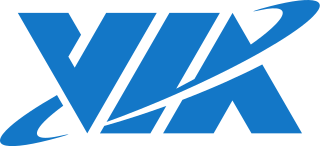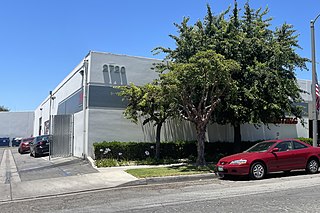
The IBM Personal Computer is the first microcomputer released in the IBM PC model line and the basis for the IBM PC compatible de facto standard. Released on August 12, 1981, it was created by a team of engineers and designers directed by William C. Lowe and Philip Don Estridge in Boca Raton, Florida.
The Motorola 68000 series is a family of 32-bit complex instruction set computer (CISC) microprocessors. During the 1980s and early 1990s, they were popular in personal computers and workstations and were the primary competitors of Intel's x86 microprocessors. They were best known as the processors used in the early Apple Macintosh, the Sharp X68000, the Commodore Amiga, the Sinclair QL, the Atari ST and Falcon, the Atari Jaguar, the Sega Genesis, the Philips CD-i, the Capcom System I (Arcade), the AT&T UNIX PC, the Tandy Model 16/16B/6000, the Sun Microsystems Sun-1, Sun-2 and Sun-3, the NeXT Computer, NeXTcube, NeXTstation, and NeXTcube Turbo, early Silicon Graphics IRIS workstations, computers from MASSCOMP, the Texas Instruments TI-89/TI-92 calculators, the Palm Pilot, the Control Data Corporation CDCNET Device Interface, and the Space Shuttle. Although no modern desktop computers are based on processors in the 680x0 series, derivative processors are still widely used in embedded systems.

ATI Technologies Inc., commonly called ATI, was a Canadian semiconductor technology corporation based in Markham, Ontario, that specialized in the development of graphics processing units and chipsets. Founded in 1985, the company listed publicly in 1993 and was acquired by AMD in 2006. As a major fabrication-less or fabless semiconductor company, ATI conducted research and development in-house and outsourced the manufacturing and assembly of its products. With the decline and eventual bankruptcy of 3dfx in 2000, ATI and its chief rival Nvidia emerged as the two dominant players in the graphics processors industry, eventually forcing other manufacturers into niche roles.

VIA Technologies Inc., is a Taiwanese manufacturer of integrated circuits, mainly motherboard chipsets, CPUs, and memory. It was the world's largest independent manufacturer of motherboard chipsets. As a fabless semiconductor company, VIA conducts research and development of its chipsets in-house, then subcontracts the actual (silicon) manufacturing to third-party merchant foundries such as TSMC.

In a computer system, a chipset is a set of electronic components on one or more integrated circuits that manages the data flow between the processor, memory and peripherals. The chipset is usually found on the motherboard of computers. Chipsets are usually designed to work with a specific family of microprocessors. Because it controls communications between the processor and external devices, the chipset plays a crucial role in determining system performance.

A graphics processing unit (GPU) is a specialized electronic circuit initially designed to accelerate computer graphics and image processing. After their initial design, GPUs were found to be useful for non-graphic calculations involving embarrassingly parallel problems due to their parallel structure. Other non-graphical uses include the training of neural networks and cryptocurrency mining.

Chips and Technologies, Inc. (C&T), was an early fabless semiconductor company founded in Milpitas, California, in December 1984 by Gordon A. Campbell and Dado Banatao.

S3 Graphics, Ltd. was an American computer graphics company. The company sold the Trio, ViRGE, Savage, and Chrome series of graphics processors. Struggling against competition from 3dfx Interactive, ATI and Nvidia, it merged with hardware manufacturer Diamond Multimedia in 1999. The resulting company renamed itself to SONICblue Incorporated, and, two years later, the graphics portion was spun off into a new joint effort with VIA Technologies. The new company focused on the mobile graphics market. VIA Technologies' stake in S3 Graphics was purchased by HTC in 2011.

Number Nine Visual Technology Corporation was a manufacturer of video graphics chips and cards from 1982 to 1999. Number Nine developed the first 128-bit graphics processor, as well as the first 256-color (8-bit) and 16.8 million color (24-bit) cards.
Cirrus Logic Inc. is an American fabless semiconductor supplier that specializes in analog, mixed-signal, and audio DSP integrated circuits (ICs). Since 1998, the company's headquarters have been in Austin, Texas.

Diamond Multimedia is an American company that specializes in many forms of multimedia technology. They have produced graphics cards, motherboards, modems, sound cards and MP3 players; however, the company began with the production of the TrackStar, a PC add-on card which emulated Apple II computers. They were one of the major players in the 2D and early 3D graphics card competition throughout the 1990s and early 2000s.

Iguig, officially the Municipality of Iguig, is a 4th class municipality in the province of Cagayan, Philippines. According to the 2020 census, it has a population of 30,060 people.

Rendition, Inc., was a maker of 3D computer graphics chipsets in the mid to late 1990s. They were known for products such as the Vérité 1000 and Vérité 2x00 and for being one of the first 3D chipset makers to directly work with Quake developer John Carmack to make a hardware-accelerated version of the game (vQuake). Rendition's major competitor at the time was 3Dfx. Their proprietary rendering APIs were Speedy3D and RRedline.

Media Vision Technology, Inc., was an American electronics manufacturer of primarily computer sound cards and CD-ROM kits, operating from 1990 to approximately 1995 in Fremont, California. Media Vision was widely known for its Pro AudioSpectrum PC sound cards—which it often bundled with CD-ROM drives—it is also known for its spectacular growth and demise.

The history of the personal computer as a mass-market consumer electronic device began with the microcomputer revolution of the 1970s. A personal computer is one intended for interactive individual use, as opposed to a mainframe computer where the end user's requests are filtered through operating staff, or a time-sharing system in which one large processor is shared by many individuals. After the development of the microprocessor, individual personal computers were low enough in cost that they eventually became affordable consumer goods. Early personal computers – generally called microcomputers – were sold often in electronic kit form and in limited numbers, and were of interest mostly to hobbyists and technicians.

American Computer & Peripheral, Inc. (AC&P), also written as American Computer and Peripheral, was an American computer company based in Santa Ana, California. The company was founded in 1985 by Alan Lau and released several expansion boards for the IBM PC as well as a few PC clones before going bankrupt in December 1989. Obscure in its own time, the company's 386 Translator was the first plug-in board for Intel's newly released 80386 processor and the first mass-market computing device to offer consumers a means of using the 386 in July 1986.














